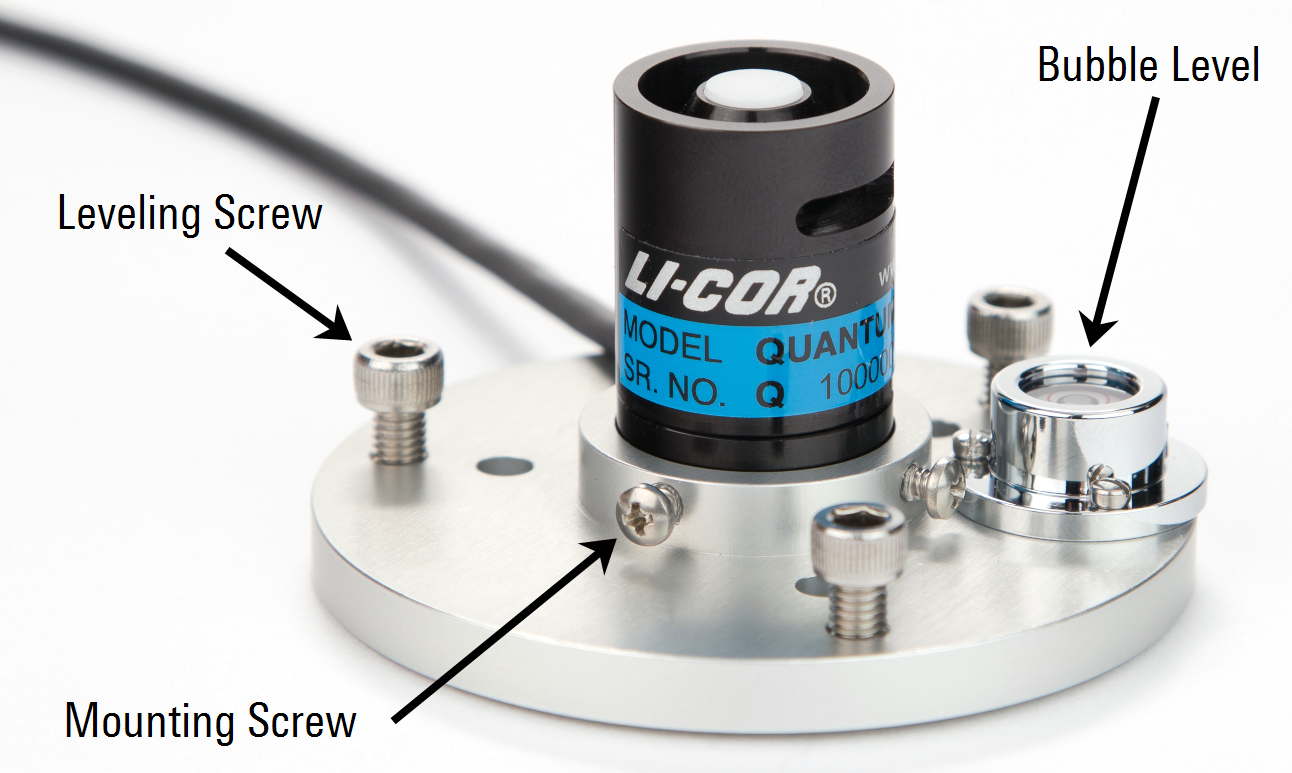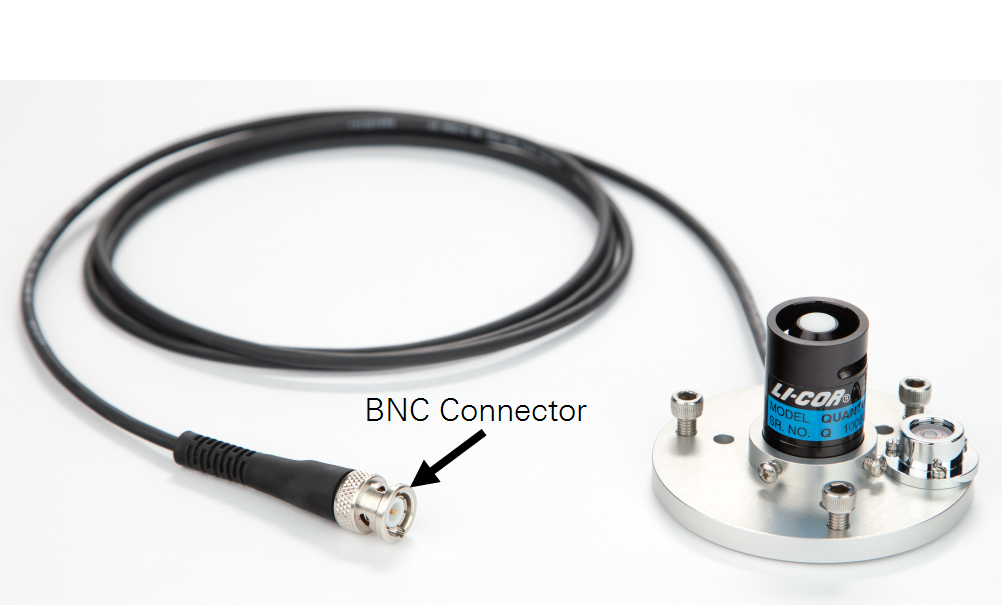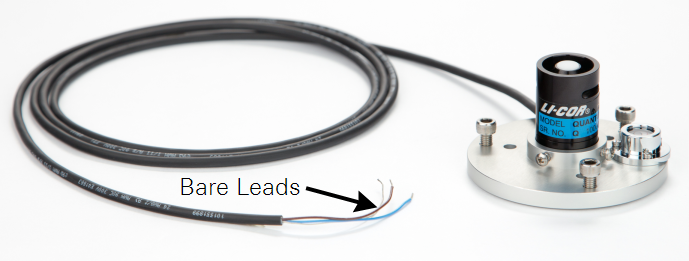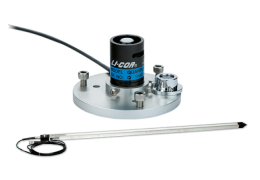Mounting the LI-190R Quantum Sensor
The LI-190R Quantum Sensor may be hand-held or mounted to an instrument platform. For best results, install your sensor in the 2003S Mounting and Leveling Fixture. Secure the sensor in the fixture by tightening the mounting screws against the sensor base. Level the fixture with the bubble by adjusting the three leveling screws. The 2003S Mounting and Leveling Fixture can be secured to a structure with bolts or screws placed through the three holes in the fixture.

Secure cables to the instrument platform using cable ties. Be sure there is no strain on the junction where the cable enters the sensor housing, and use a cable tie at any sharp bends in the cable.
Mounting the LI-191R Line Quantum Sensor
The LI-191R can be hand held or mounted to an instrument platform. The sensor should be level as much as possible when in use. Error induced by inexact leveling is usually very small compared to the other sources of error. Therefore, slightly out-of-level mounting may be preferred to prevent water from pooling on the diffuser.
Quick measurements can be made within a crop canopy by supporting the sensor with one hand and extending it into the canopy. The LI-191R can be used for absolute measurements above a canopy, but the LI-190R is preferred for above-canopy radiation measurements.
The sensor is sealed against moisture, except for the BNC connector. Nevertheless, mount the sensor so that water does not pool on the acrylic diffuser. The LI-191R should not be submerged in water.
An anodized aluminum cone is provided with the LI-191R. It is used to ease insertion into plant canopies or dense vegetation. It threads into the tip of the sensor.
Caution: Do not drop the LI-191R. It could be damaged in a drop and the point of the nose cone could cause injury.
Calibration Constants and Multipliers
Each LI-COR radiation sensor is shipped with a certificate of calibration. The certificate is also available at www.licor.com/support/. Enter the sensor's serial number in the calibration search box. The calibration constant and multipliers are listed on the certificate in the following order:
Calibration constant
The current signal produced by a LI-COR quantum sensor is related to radiation intensity with a calibration constant unique to each sensor, expressed in units of µA per 1000 µmol s-1 m-2. The calibration constant is used to compute calibration multipliers.
Multiplier for use with LI-COR handheld meters and loggers
LI-COR handheld meters and loggers convert the current (μA) signal into units of radiation (µmol s-1 m-2) by applying this multiplier, expressed in radiation units per current (µmol s-1 m-2 µA-1). This multiplier is a negative number.
Multiplier for use with LI-190R-BL (3-wire bare leads)
This multiplier is expressed in radiation units per current (µmol s-1 m-2 µA-1) and is a positive number.
Multiplier for use with LI-COR 2290 (604 Ω) Millivolt Adapter
This multiplier is expressed in radiation units per voltage (µmol s-1 m-2 mV-1) and is a negative number.
Multiplier for use with SMV quantum sensors
The final multiplier listed is ‑200.0 µmol s-1 m-2 mV-1. The multiplier is the same for any LI-190R-SMV Quantum Sensor or LI-191R-SMV Line Quantum Sensor because the resistance of the included standard output millivolt adapter (part number 2319) is adjusted to each sensor's current output.
Using the LI-190R-BNC or LI-191R-BNC
Connect the BNC-type cable directly to a BNC input port on an LI-250A Light Meter, LI-1400 Datalogger, or LI-1500 Light Sensor Logger. These devices directly measure the current (μA) signal from the sensor. Enter the sensor's multiplier (see Multiplier for use with LI-COR handheld meters and loggers) into the device to determine PAR expressed in units of µmol s-1 m-2.


Using the LI-190R-BL Quantum Sensor

A BL-type sensor cable terminates with bare wire leads. Connect the bare leads to the input terminal block of a device that directly measures a current (μA) signal. The blue wire carries a positive signal and the brown wire is negative. Connecting the bare (shield) wire to ground will reduce noise in the sensor signal.
To log radiation units (µmol s-1 m-2), configure the recording device to multiply the μA signal by the sensor's multiplier (see Multiplier for use with LI-190R-BL (3-wire bare leads)) prior to logging the values. If logging the μA sensor signal, apply the multiplier after logging.
The LI-190R-BL can be used with recording devices that require a voltage (mV) signal by adding a precision resistor (see Voltage Signal Options).
Voltage Signal Options
If the meter or logging device requires a voltage signal, options include:
- LI-190R-BNC or LI-191R-BNC coupled with a 2290 Millivolt Adapter. The 2290 Millivolt Adapter includes a precision resistor that converts the current (µA) signal from the sensor into a millivolt-level voltage (2290 Millivolt Adapter).
- LI-190R-SMV Quantum Sensor or LI-191R-SMV Line Quantum Sensor. An SMV-type quantum sensor includes a Standardized Millivolt Adapter (part number 2319) matched to a particular sensor. The serial numbers on the adapter and the sensor must match! The advantage over the 2290 Millivolt Adapter is that the multiplier in your device does not need to be changed for different sensors (LI-190R-SMV or LI-191R-SMV Quantum Sensor).
- LI-190R or LI-191R coupled with a 2420 Light Sensor Amplifier. The 2420 Amplifier converts the current (µA) signal from the sensor into a voltage (2420 Light Sensor Amplifier).
- LI-190R-BL coupled with a precision resistor. Connect the resistor across the positive and negative leads of the cable. The recommended resistance is 604 Ω, with a maximum output of approximately 10 mV per 2000 µmol s-1 m-2. See 2290 Millivolt Adapter for instructions on calculating the multiplier, but use the absolute value of the multiplier.
With a Millivolt Adapter or other resistor, the signal to noise ratio (sensitivity) is lower than with the 2420 Light Sensor Amplifier, but the cost is less and there is no need for a power supply to the adapter.
Caution: Do not attach the sensor to a power source. The sensor is self-powered.

